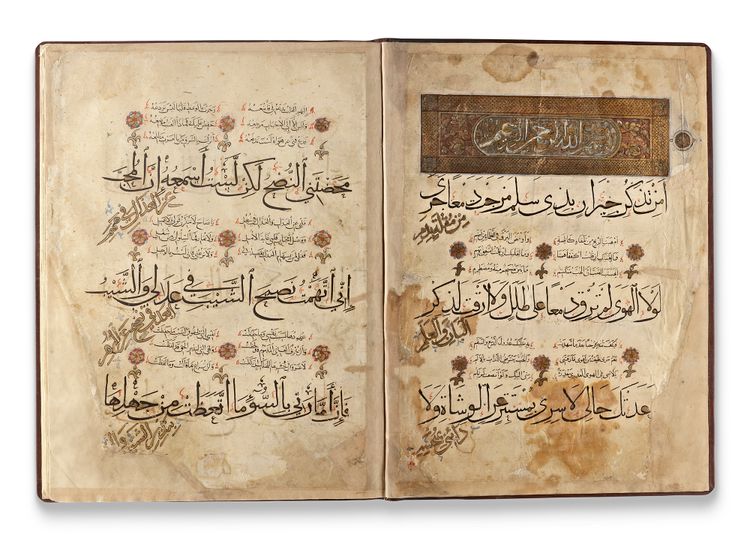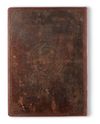Lot 96 MUHAMMAD BIN SA'ID AL-BUSIRI (D. 1296): QASIDA AL-BURDA ('ODE OF THE MANTLE'), MAMLUK NEAR EAST, DATED 853 AH/1449 AD
Arabic manuscript on paper, 25ff., each page with three large black Muhaqqa script ending with 2-3 words in gold script outlined in black, 9ll. of smaller black naskh script arranged in three columns, gold rosette poems divisions outlined in black and pointed by red points, golf and red floral decoration. F1.b page with gilt and polychrome decoration enclosing the Basmallah, the last page signed" The blessed Burda was completed, thanks to God’s grace, help, and good success, by the humble servant Yusuf Al-Bayadi", and dated 853AH/ 1449AD.
The first page features a gilt and polychrome floral roundel enclosing the dedication:
"For the treasury of our lord, the Sultan, the Possessor, the King, al-Zahir Abu Sa‘id Jaqmaq."
In deep brown leather binding.
26 by 35 cm.
Catalogue Note:
This manuscript, dated 853 AH/1449 AD, was produced during the reign of Sultan Sayf al-Din Jaqmaq (r. 1438–1453), a prominent figure of the Burji Mamluk period. Of Circassian origin, Jaqmaq rose from the Mamluk military ranks to assume the sultanate, navigating a complex political landscape marked by internal factionalism and external pressures. His rule is distinguished by efforts to stabilize the realm, centralize authority, and reaffirm Mamluk prestige at a time when regional power dynamics were rapidly shifting—particularly with the rise of the Ottoman Empire and renewed Western incursions in the eastern Mediterranean.
Jaqmaq is also remembered for his commitment to Islamic learning and the arts. He was a notable patron of architecture and manuscript production, supporting the embellishment of religious and scholarly institutions throughout Cairo and the broader Mamluk territories. Under his rule, the arts of the book flourished, often combining luxurious materials with a high degree of calligraphic and ornamental sophistication.
The present manuscript is a striking example of this flourishing artistic culture. Its script and layout reveal a conscious synthesis of aesthetic refinement and devotional purpose. The use of Muhaqqaq—a majestic, formal script traditionally reserved for Qur'anic and ceremonial texts—combined with smaller Naskh script arranged in carefully balanced columns, reflects both technical mastery and reverence for the text. The gold-outlined calligraphy and the intricate floral and geometric embellishments in red and gold further underscore the manuscript’s ceremonial importance.
Particularly noteworthy is the dedication to “our lord, the sultan, the possessor, the king Al-Zahir Abu Sa‘id Jaqmaq,” prominently placed within a polychrome floral roundel on the opening folio. This suggests the manuscript may have been commissioned for the royal treasury or as an offering to the Sultan himself, perhaps in the context of a religious or state celebration.
The colophon, penned by the scribe Yusuf al-Bayadi, adds an important personal and historical dimension. By naming himself “the humble servant” and expressing gratitude for divine assistance in completing the work, the scribe aligns himself with a longstanding tradition of devotional humility in manuscript culture. The inclusion of a precise date anchors the manuscript firmly within the historical framework of mid-15th century Mamluk Egypt, offering valuable insight into the intellectual and artistic priorities of the court.
Taken as a whole, this manuscript is a testament not only to the aesthetic ideals of its time but also to the religious, political, and cultural ambitions of the Mamluk elite. It stands as a refined and richly layered artifact of a vibrant period in Islamic manuscript production.





